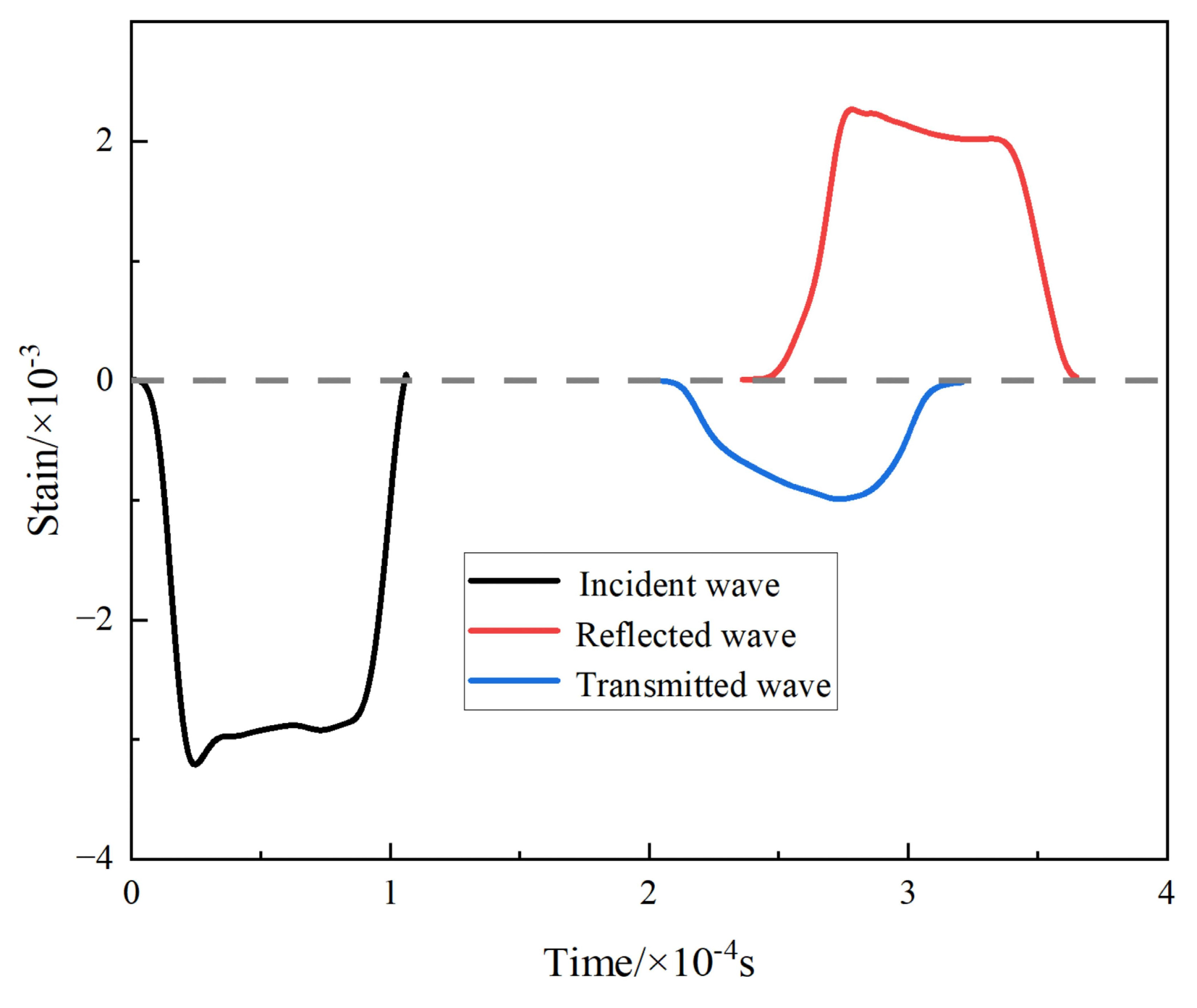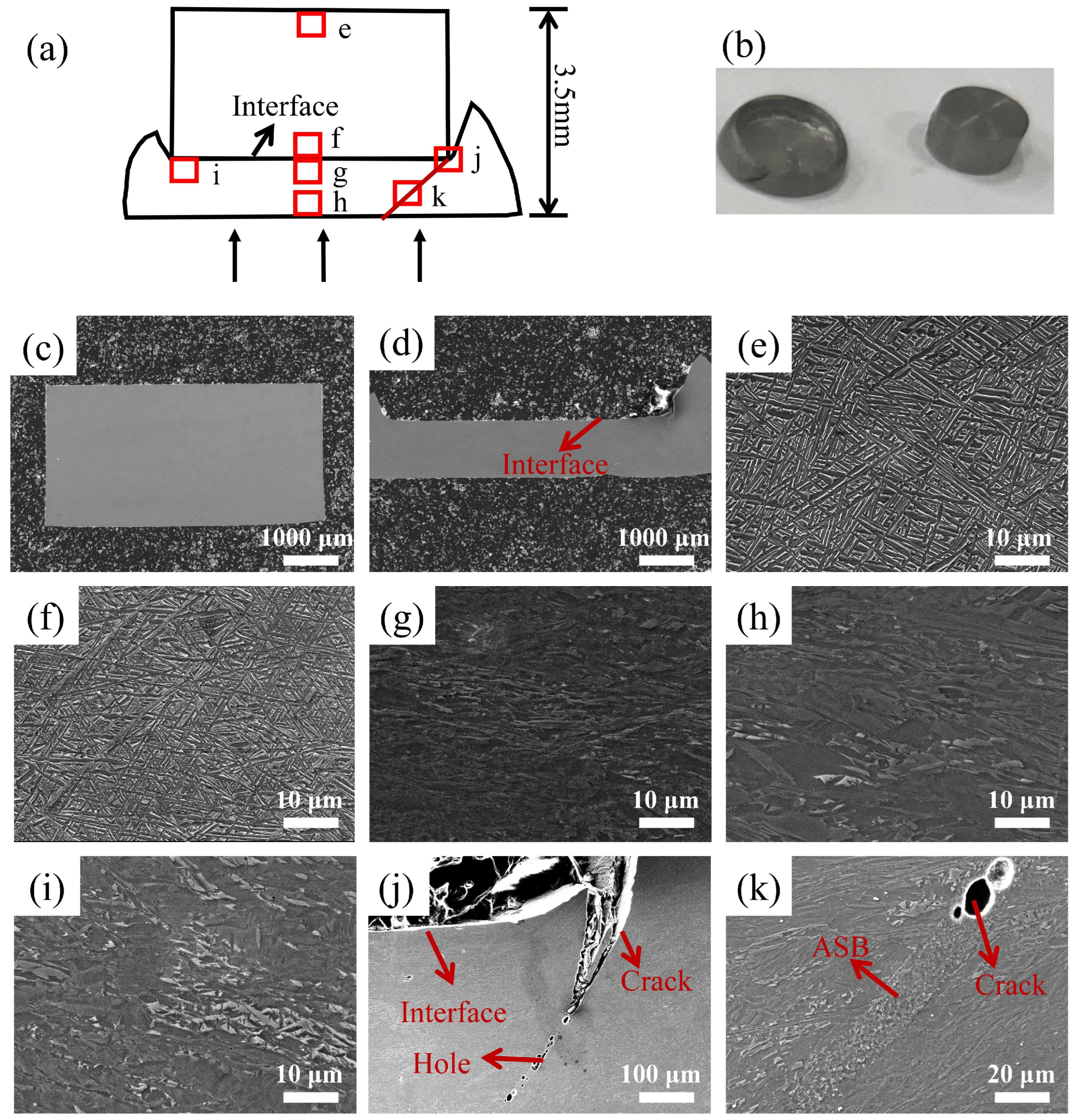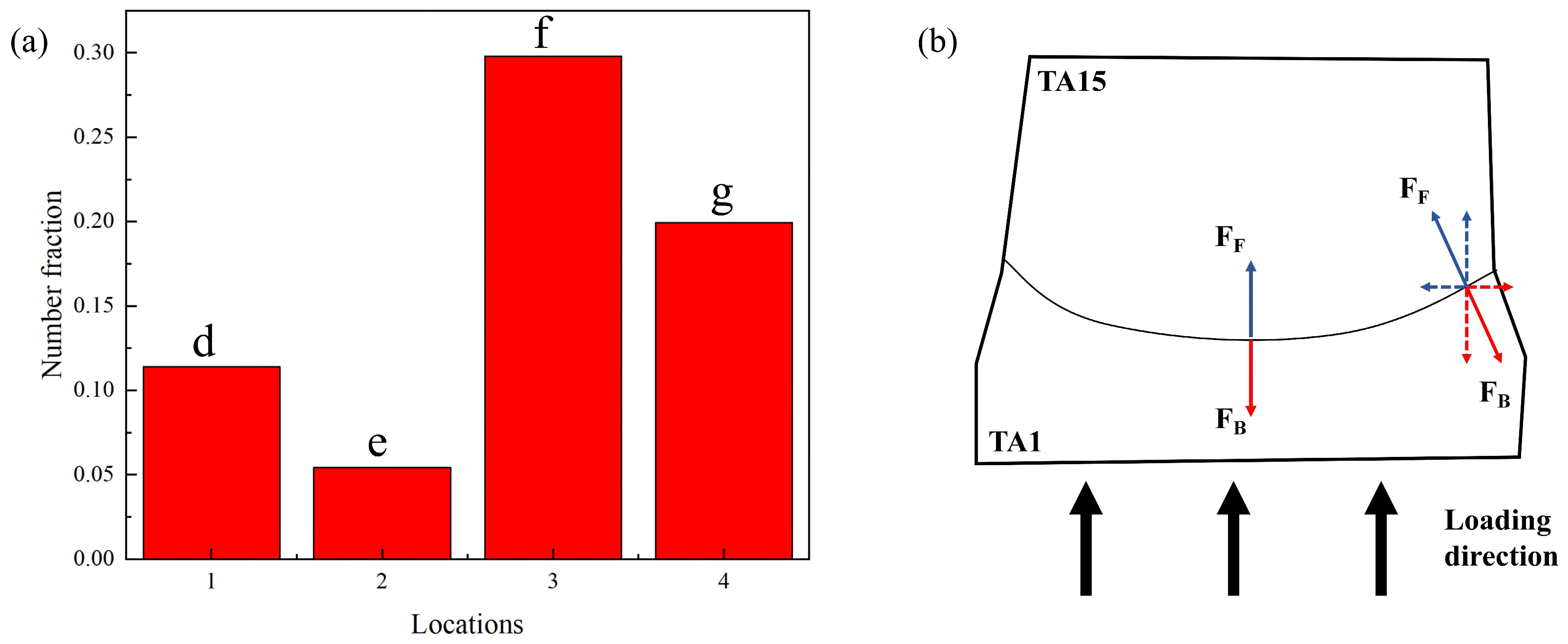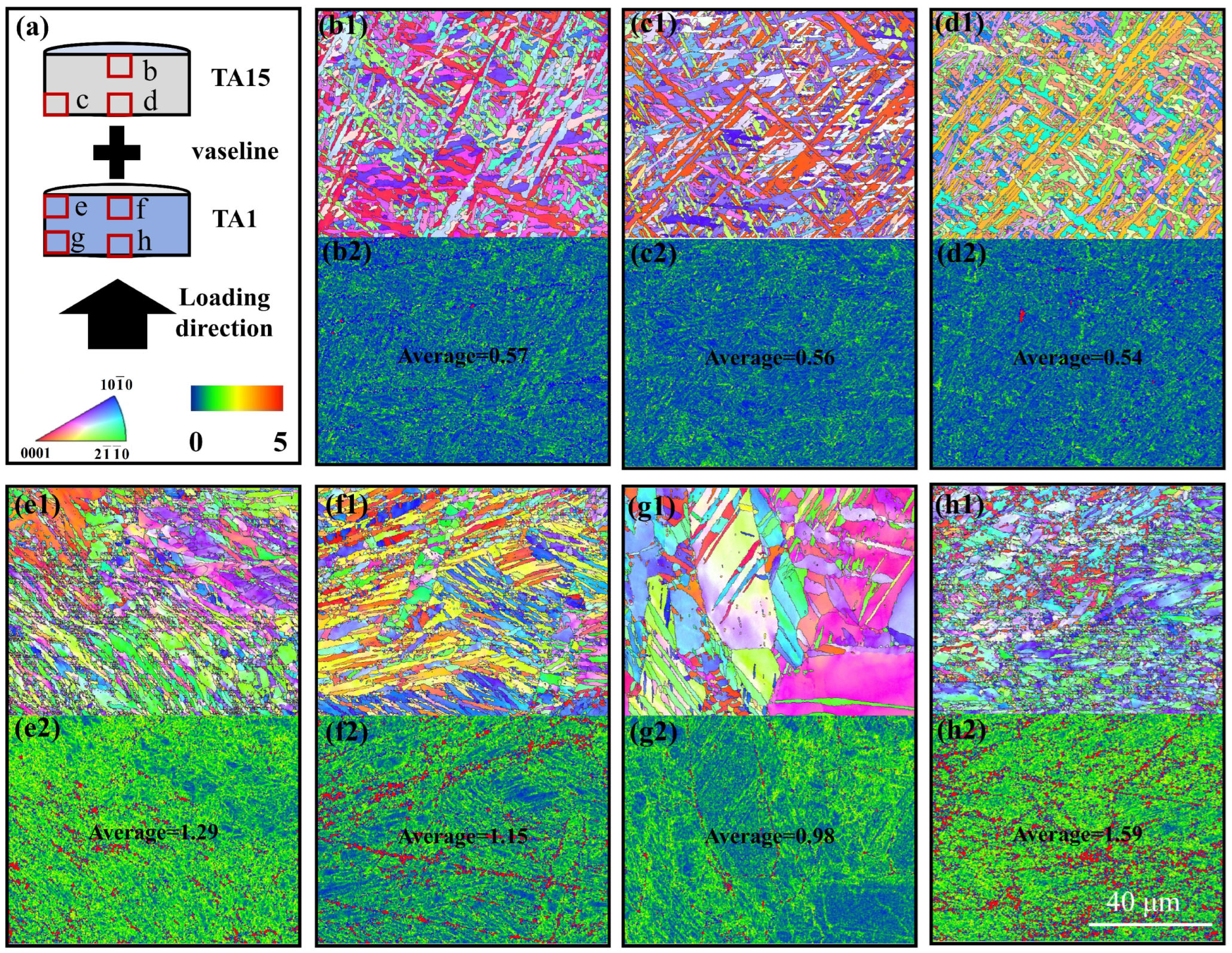Influence of Interface Type on Dynamic Deformation Behavior of 3D-Printed Heterogeneous Titanium Alloy Materials
Abstract
:1. Introduction
2. Materials and Methods
3. Results and Discussion
3.1. Microstructure of Heterogeneous Material TA1/TA15 before Deformation
3.2. Dynamic Mechanical Properties of TA1/TA15
3.3. Microstructure State of TA1/TA15 after Deformation
4. Conclusions
- (1)
- Compared to the NMB, the MB has better resistance to adiabatic shear breakage and absorbs more energy per unit volume before damage occurs, a year-on-year improvement of about 12%.
- (2)
- In both HS materials, the ASB is concentrated in the TA1 portion, sprouting from the edge of the interface, expanding in the 45° direction, and eventually forming a “V-shaped” crack.
- (3)
- For MB, near the surface of TA15 carries less stress, both TA1 and TA15 microstructures near the interface carry more stress. There are two deformation mechanisms, slip and twinning, within the TA1 microstructure. The dislocation density at the interface is large, and slip is the main deformation mechanism; near the TA1 surface, twinning is the main deformation mechanism, and -type tensile twins and type compression twins exist.
- (4)
- Compared to the MB, the TA15 portion of the NMB carries almost no stress due to its poor ability to coordinate deformation near the interface, but the TA1 portion of the NMB carries more stress and thus will experience damage earlier than the MB.
Author Contributions
Funding
Institutional Review Board Statement
Informed Consent Statement
Data Availability Statement
Conflicts of Interest
References
- Colorado, H.A.; Cardenas, C.A.; Gutierrez-Velazquez, E.I.; Escobedo, J.P.; Monteiro, S.N. Additive manufacturing in armor and military applications: Research, materials, processing technologies, perspectives, and challenges. J. Mater. Res. Technol. 2023, 27, 3900–3913. [Google Scholar] [CrossRef]
- Alaghmandfard, R.; Chalasani, D.; Odeshi, A.; Mohammadi, M. Activated slip and twin systems in electron beam melted Ti-6Al-4V subjected to elevated and high strain rate dynamic deformations. Mater. Charact. 2021, 172, 110866. [Google Scholar] [CrossRef]
- Alaghmandfard, R.; Seraj, P.; Sanjari, M.; Pirgazi, H.; Dharmendra, C.; Odeshi, A.G.; Shalchi Amirkhiz, B.; Mohammadi, M. High strain rate deformation behavior, texture and microstructural evolution, characterization of adiabatic shear bands, and constitutive models in electron beam melted Ti-6Al-4V under dynamic compression loadings. J. Mater. Res. Technol. 2022, 21, 4093–4114. [Google Scholar] [CrossRef]
- Salehi, S.-D.; Beal, R.; Kingstedt, O.T. Dynamic behavior and thermomechanical characterization of laser powder bed fusion and wrought Ti–6Al–4V. Int. J. Impact Eng. 2023, 176, 104552. [Google Scholar] [CrossRef]
- Awannegbe, E.; Chen, L.; Zhao, Y.; Qiu, Z.; Li, H. Effect of thermomechanical processing on compressive mechanical properties of Ti–15Mo additively manufactured by laser metal deposition. Mater. Sci. Eng. A 2024, 889, 145834. [Google Scholar] [CrossRef]
- Sukumar, G.; Patra, A.K.; Kumar, A.; Thakur, R.K.; Singh, B.B.; Bhattacharjee, A.; Sarma, V.S. A comparative study on dynamic deformation and ballistic impact response of Ti–4Al–2.5V–1.5Fe–0.25O and Ti–6Al–4V alloys. Mater. Sci. Eng. A 2024, 889, 101019. [Google Scholar] [CrossRef]
- Zhu, Y.; Wu, X. Heterostructured materials. Prog. Mater. Sci. 2023, 131, 101019. [Google Scholar] [CrossRef]
- Ashby, M.F. The deformation of plastically non-homogeneous materials. Philos. Mag. A J. Theor. Exp. Appl. Phys. 2006, 21, 399–424. [Google Scholar] [CrossRef]
- Wang, M.; Guo, F.; He, Q.; Su, W.; Ran, H.; Cheng, Q.; Kim, H.S.; Wang, Q.; Huang, C. Superior strength-ductility synergy by microstructural heterogeneities in pure titanium. Mater. Sci. Eng. A 2023, 883, 145513. [Google Scholar] [CrossRef]
- Zhang, D.; Zhang, M.; Lin, R.; Liu, G.; Li, J.; Feng, Y. Strengthening and strain hardening mechanisms of a plain medium carbon steel by multiscale lamellar structures. Mater. Sci. Eng. A 2021, 827, 142091. [Google Scholar] [CrossRef]
- Liu, X.L.; Xue, Q.Q.; Wang, W.; Zhou, L.L.; Jiang, P.; Ma, H.S.; Yuan, F.P.; Wei, Y.G.; Wu, X.L. Back-stress-induced strengthening and strain hardening in dual-phase steel. Materialia 2019, 7, 100376. [Google Scholar] [CrossRef]
- Bhagirath Jadhav, A.; Gaikwad, A.; Gori, Y.; Somaiah, A.; Rambabu, G.V.; Al-Ataby, F.H.; Saxena, K.K. A review of armour’s use of composite materials. Mater. Today Proc. 2023. [Google Scholar] [CrossRef]
- Wu, H.; Fan, G. An overview of tailoring strain delocalization for strength-ductility synergy. Prog. Mater. Sci. 2020, 113, 100675. [Google Scholar] [CrossRef]
- Daram, P.; Hiroto, T.; Watanabe, M. Microstructure and phase evolution of functionally graded multi-materials of Ni–Ti alloy fabricated by laser powder bed fusion process. J. Mater. Res. Technol. 2023, 23, 5559–5572. [Google Scholar] [CrossRef]
- Dixit, S.; Dash, B.B.; Kumar, D.; Bhattacharjee, A.; Sankaran, S. Influence of phase morphology, static recrystallization, and crystallographic texture on room temperature tensile properties of Ti–6Al–4V alloy: Comparison between post-tested equiaxed, bimodal, and lamellar microstructures. Mater. Sci. Eng. A 2023, 873, 144990. [Google Scholar] [CrossRef]
- Ji, W.; Zhou, R.; Vivegananthan, P.; See Wu, M.; Gao, H.; Zhou, K. Recent progress in gradient-structured metals and alloys. Prog. Mater. Sci. 2023, 140, 101194. [Google Scholar] [CrossRef]
- Park, C.W.; Hajra, R.N.; Kim, S.H.; Lee, S.-H.; Kim, J.H. Optimizing multi-interlayered additive manufacturing for high strength robust joints in Inconel 718 and Ti–6Al–4V alloys. J. Mater. Res. Technol. 2023, 25, 855–872. [Google Scholar] [CrossRef]
- Jeong, H.-I.; Kim, D.-H.; Lee, C.-M. Multi-material deposition of Inconel 718 and Ti–6Al–4V using the Ti–Nb–Cr–V–Ni high entropy alloy intermediate layer. J. Mater. Res. Technol. 2024, 29, 3217–3227. [Google Scholar] [CrossRef]
- Huang, C.X.; Wang, Y.F.; Ma, X.L.; Yin, S.; Höppel, H.W.; Göken, M.; Wu, X.L.; Gao, H.J.; Zhu, Y.T. Interface affected zone for optimal strength and ductility in heterogeneous laminate. Mater. Today 2018, 21, 713–719. [Google Scholar] [CrossRef]
- Wu, H.; Huang, M.; Xia, Y.; Li, X.; Li, R.; Liu, C.; Gan, W.; Xiao, T.; Geng, L.; Liu, Q.; et al. The importance of interfacial stress-affected zone in evading the strength-ductility trade-off of heterogeneous multi-layered composites. Int. J. Plast. 2023, 160, 103485. [Google Scholar] [CrossRef]
- Lu, X.; Zhao, J.; Wang, Q.; Ran, H.; Wang, Q.; Huang, C. Effect of stress/strain partition on the mechanical behavior of heterostructured laminates: A strain gradient plasticity modeling. Results Eng. 2023, 20, 101631. [Google Scholar] [CrossRef]
- Zhuo, X.; Gao, W.; Zhao, L.; Zhao, S.; Liu, H.; Hu, Z.; Zhang, P.; Wu, Y.; Jiang, J.; Ma, A. A bimodal grain structured Zn-0.4Mg-0.02Mn alloy with superior strength-ductility synergy. Mater. Sci. Eng. A 2023, 862, 144514. [Google Scholar] [CrossRef]
- Hua, A.; Su, Y.; Cai, Y.; Cao, H.; Liu, K.; Guan, L.; Zhang, D.; Ouyang, Q. Balanced strength and ductility in B4C/SiC/2024Al composite with multimodal grain structure achieved by multistep ball milling and powder metallurgy. Mater. Charact. 2023, 201, 112896. [Google Scholar] [CrossRef]
- Yu, Y.; Wang, X.; Wu, Y.; Ma, M.; Gao, G. The impact of backplate support conditions on ceramic fracture and energy absorption in the penetration resistance process of ceramic/metal composite armor. Ceram. Int. 2024, 50, 10325–10339. [Google Scholar] [CrossRef]
- Pan, G.; Su, H.; Li, X.; Wang, J. Coupled FEM-SPH simulation of the protective properties for metal/ceramic composite armor. Int. J. Lightweight Mater. Manuf. 2023, 6, 543–551. [Google Scholar] [CrossRef]
- Miao, Y.; Yuan, M.; Fan, Z.; Wang, X.; Li, Z.; Zhou, X.; Wang, H. Effect of hot-pressing temperature on microstructure and the improvement of residual Al on tensile ductility of Ti/Al3Ti heterogeneous structure. Mater. Sci. Eng. A 2022, 860, 144291. [Google Scholar] [CrossRef]
- Fan, W.; Dong, L.; Zheng, F.; Li, M.; Sun, G.; Xu, J.; Li, X.; Fu, Y.; Elmarakbi, A.; Wang, L.; et al. Heterogeneous network structures formed in TiC/TC4/β-Ti composites for enhancing strength with good ductility. Compos. Commun. 2023, 42, 101697. [Google Scholar] [CrossRef]
- Jiang, P.F.; Nie, M.H.; Teng, J.Z.; Liu, C.Z.; Zhang, Z.H. Multi-wire arc additive manufacturing of TC4-Nb-NiTi bionic layered heterogeneous alloy: Microstructure evolution and mechanical properties. Mater. Charact. 2023, 202, 113001. [Google Scholar] [CrossRef]
- Shakil, M.; Ahmad, M.; Tariq, N.H.; Hasan, B.A.; Akhter, J.I.; Ahmed, E.; Mehmood, M.; Choudhry, M.A.; Iqbal, M. Microstructure and hardness studies of electron beam welded Inconel 625 and stainless steel 304L. Vacuum 2014, 110, 121–126. [Google Scholar] [CrossRef]
- Carroll, B.E.; Otis, R.A.; Borgonia, J.P.; Suh, J.-o.; Dillon, R.P.; Shapiro, A.A.; Hofmann, D.C.; Liu, Z.-K.; Beese, A.M. Functionally graded material of 304L stainless steel and inconel 625 fabricated by directed energy deposition: Characterization and thermodynamic modeling. Acta Mater. 2016, 108, 46–54. [Google Scholar] [CrossRef]
- Liu, Y.; Zhang, Y. Microstructure and mechanical properties of TA15-Ti2AlNb bimetallic structures by laser additive manufacturing. Mater. Sci. Eng. A 2020, 795, 140019. [Google Scholar] [CrossRef]
- Wang, H.; Ma, S.-Y.; Wang, J.-C.; Lu, T.; Liu, C.-M. Microstructure and mechanical properties of TA15/TC11 graded structural material by wire arc additive manufacturing process. Trans. Nonferrous Met. Soc. China 2021, 31, 2323–2335. [Google Scholar] [CrossRef]
- Pacheco, J.T.; Meura, V.H.; Bloemer, P.R.A.; Veiga, M.T.; de Moura Filho, O.C.; Cunha, A.; Teixeira, M.F. Laser directed energy deposition of AISI 316L stainless steel: The effect of build direction on mechanical properties in as-built and heat-treated conditions. Adv. Ind. Manuf. Eng. 2022, 4, 100079. [Google Scholar] [CrossRef]
- Zhang, F.; Shen, Y.; Yang, K.; Ma, X.; Yang, H. Microstructure and hardness of S304/Ni25/TC4 functionally graded materials fabricated by laser solid forming. Vacuum 2024, 222, 113055. [Google Scholar] [CrossRef]
- He, J.; Yuan, F.; Yang, M.; Jiao, S.; Wu, X. Superior mechanical properties and deformation mechanisms of heterogeneous laminates under dynamic shear loading. Mater. Sci. Eng. A 2019, 756, 492–501. [Google Scholar] [CrossRef]
- Guo, Y.-s.; Chen, P.-w.; Arab, A.; Zhou, Q.; Mahmood, Y. High strain rate deformation of explosion-welded Ti6Al4V/pure titanium. Def. Technol. 2020, 16, 678–688. [Google Scholar] [CrossRef]
- Liang, Y.-J.; Liu, D.; Wang, H.-M. Microstructure and mechanical behavior of commercial purity Ti/Ti–6Al–2Zr–1Mo–1V structurally graded material fabricated by laser additive manufacturing. Scr. Mater. 2014, 74, 80–83. [Google Scholar] [CrossRef]
- Fang, X.T.; He, G.Z.; Zheng, C.; Ma, X.L.; Kaoumi, D.; Li, Y.S.; Zhu, Y.T. Effect of heterostructure and hetero-deformation induced hardening on the strength and ductility of brass. Acta Mater. 2020, 186, 644–655. [Google Scholar] [CrossRef]
- Kennedy, J.R.; Davis, A.E.; Caballero, A.E.; White, M.; Fellowes, J.; Pickering, E.J.; Prangnell, P.B. Microstructure transition gradients in titanium dissimilar alloy (Ti-5Al-5V-5Mo-3Cr/Ti-6Al-4V) tailored wire-arc additively manufactured components. Mater. Charact. 2021, 182, 111577. [Google Scholar] [CrossRef]
- Jiang, P.F.; Nie, M.H.; Zong, X.M.; Wang, X.B.; Chen, Z.K.; Liu, C.Z.; Teng, J.Z.; Zhang, Z.H. Microstructure and mechanical properties of TC4/NiTi bionic gradient heterogeneous alloy prepared by multi-wire arc additive manufacturing. Mater. Sci. Eng. A 2023, 866, 144678. [Google Scholar] [CrossRef]










| Ti | Al | Mo | V | Zr | Fe | N | C | H | O | |
|---|---|---|---|---|---|---|---|---|---|---|
| TA15 (powder) | Bal. | 6.56 | 1.92 | 2.32 | 2.26 | 0.048 | 0.010 | 0.019 | 0.0027 | 0.122 |
| TA1 (powder) | Bal. | - | - | - | - | 0.019 | 0.003 | 0.008 | 0.001 | 0.064 |
| TA15 (printed) | Bal. | 6.60 | 1.62 | 2.08 | 2.20 | 0.062 | 0.092 | 0.016 | 0.0024 | 0.12 |
| TA1 (printed) | Bal. | - | - | - | - | 0.024 | 0.0094 | 0.0086 | <0.002 | 0.049 |
Disclaimer/Publisher’s Note: The statements, opinions and data contained in all publications are solely those of the individual author(s) and contributor(s) and not of MDPI and/or the editor(s). MDPI and/or the editor(s) disclaim responsibility for any injury to people or property resulting from any ideas, methods, instructions or products referred to in the content. |
© 2024 by the authors. Licensee MDPI, Basel, Switzerland. This article is an open access article distributed under the terms and conditions of the Creative Commons Attribution (CC BY) license (https://creativecommons.org/licenses/by/4.0/).
Share and Cite
Li, A.; Luo, Y.; Wang, B.; Song, X. Influence of Interface Type on Dynamic Deformation Behavior of 3D-Printed Heterogeneous Titanium Alloy Materials. Materials 2024, 17, 1922. https://doi.org/10.3390/ma17081922
Li A, Luo Y, Wang B, Song X. Influence of Interface Type on Dynamic Deformation Behavior of 3D-Printed Heterogeneous Titanium Alloy Materials. Materials. 2024; 17(8):1922. https://doi.org/10.3390/ma17081922
Chicago/Turabian StyleLi, Anmi, Yumeng Luo, Boya Wang, and Xiaoyun Song. 2024. "Influence of Interface Type on Dynamic Deformation Behavior of 3D-Printed Heterogeneous Titanium Alloy Materials" Materials 17, no. 8: 1922. https://doi.org/10.3390/ma17081922






